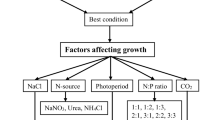Abstract
Objective
A novel filamentous cyanobacterium, a photosynthesizing microorganism, was isolated from a river, and its unique features of flocculation and pentadecane production were characterized.
Results
Microscopic observations and a phylogenetic analysis with 16S rDNA revealed that this strain was a Limnothrix species denoted as the SK1-2-1 strain. Auto cell-flocculation was observed when this strain was exposed to a two-step incubation involving a standing cultivation following a shaking preincubation. Flocculation was enhanced by blue light at a wavelength at 470 nm and irradiation for several hours to 1 day. Moreover, the strain exhibiting exponential cell growth may preferentially accumulate alkanes as pentadecane C15H32 alkane, which may be used as jet fuel, at a range of approximately 1% in the dry cell weight of flocculated cells.
Conclusion
This is the first study on biofuel production using flocculated cells in which the specific manner of production may be regulated by cultivation conditions.





Similar content being viewed by others
References
Acinas SG, Haverkamp THA, Huisman J, Stal LJ (2009) Phenotypic and genetic diversification of Pseudanabaena spp. (cyanobacteria). ISME J 3:31–46
Anderson SL, Mcintosh L (1991) Light-activated heterotrophic growth of the cyanobacterium Synechocystis sp. strain PCC 6803: a blue-light-requiring process. J Bacteriol 173:2761–2767
Asayama M (2012) Overproduction and easy recovery of target gene products from cyanobacteria, photosynthesizing microorganisms. Appl Microbiol Biotechnol 95:683–695
Coates RC, Podell S, Korobeynikov A, Lapidus A, Pevzner P, Sherman DH, Allen EE, Gerwick L, Gerwick WH (2014) Characterization of cyanobacterial hydrocarbon composition and distribution of biosynthetic pathways. PLoS ONE 9:e85140
Ducat CD, Way JC, Silver PA (2011) Engineering cyanobacteria to generate high-value products. Trends Biotechnol 29:95–103
Enomoto G, Nomura R, Shimoda T, Win-N-N, Narikawa R, Ikeuchi M (2014) Cyanobacteriochrome SesA is a diguanylate cyclase that induces cell aggregation in Thermosynechococcus. J Biol Chem 289:24801–24809
Gkelis S, Rajaniemi P, Vardaka E, Moustaka-Gouni M, Lanaras T, Sivonen K (2005) Limnothrix redekei (Van Goor) Meffert (Cyanobacteria) strains from Lake Kastoria, Greece form a separate phylogenetic group. Microbial Ecol 49:176–182
Kageyama H, Waditee-Sirisattha R, Sirisattha S, Tanaka Y, Mahakhant A, Tanaka T (2015) Improved alkane production in nitrogen-fixing and halotolerant cyanobacteria via abiotic stresses and genetic manipulation of alkane synthetic genes. Curr Microbiol 71:115–120
Kawano Y, Saotome T, Ochiai Y, Katayama M, Narikawa R, Ikeuchi M (2011) Cellulose accumulation and a cellulose synthase gene are responsible for cell aggregation in the cyanobacterium Thermosynechococcus vulcanus RKN. Plant Cell Physiol 52:957–966
Kitazaki C, Numano S, Takanezawa A, Nishizawa T, Shirai M, Asayama M (2013) Characterization of lysis of the multicellular cyanobacterium Limnothrix/Pseudanabaena sp. strain ABRG5-3. Biosci Biotech Biochem 77:2339–2347
Lee J, Cho D-H, Ramanan R, Kim B-H, Oh H-M, Kim H-S (2013) Microalgae-associated bacteria play a key role in the flocculation of Chlorella vulgaris. Biores Technol 131:195–201
Li X, Přibyl P, Bišová K, Kawano S, Cepák V, Zachleder V (2012) The microalga Parachlorella kessleri-a novel highly efficient lipid producer. Biotechnol Bioeng 110:97–107
Nishizawa T, Hanami T, Hirano E, Miura T, Watanabe Y, Takanezawa A, Komatsuzaki M, Ohta H, Shirai M, Asayama M (2010) Isolation and molecular characterization of a multicellular cyanobacterium, Limnothrix/Pseudanabaena sp. strain ABRG5-3. Biosci Biotech Biochem 74:1827–1835
Powell RJ, Hill RT (2013) Rapid aggregation of biofuel-producing algae by the bacterium Bacillus sp. strain RP1137. Appl Environ Microbiol 79:6093–6101
Rippka R (1989) Isolation and purification of cyanobacteria. Methods Enzymol 167:3–27
Rojo C, Cobelas MA (1994) Population dynamics of Limnothrix redekei, Oscillatoria lanceaeformis, Planktothrix agardhii and Pseudanabaena limnetica (cyanobacteria) in shallow hypertrophic lake (Spain). Hydrobiologia 275(276):165–171
Schirmer A, Mathew AR, Li X, Popova E, Cardayre SB (2010) Microbial biosynthesis of alkanes. Science 329:559–562
Tamura K, Stecher G, Peterson D, Filipski A, Kumar S (2013) MEGA6: molecular evolutionary genetics analysis version 6.0. Mol Biol Evol 30:2725–2729
Tanoi T, Kawachi M, Watanabe MM (2011) Effects of carbon source on growth and morphology of Botryococcus braunii. J Appl Phycol 23:25–33
Whiteman P (1973) Quantitative measurements of Alcian Blue-glycosaminoglycan complexes. Biochem J 131:343–350
Acknowledgements
This work was partially supported by a propulsive project from Ibaraki University (to MA) and PRESTO (Sakigake project) of the Japan Science and Technology Agency (to MA).
Supporting information
Supplementary Fig. 1—Cyanobacterium SK1-2-1 cells.
Supplementary Fig. 2—Phylogenetic analysis.
Author information
Authors and Affiliations
Corresponding author
Electronic supplementary material
Below is the link to the electronic supplementary material.
Rights and permissions
About this article
Cite this article
Sugawara, T., Chinzei, M., Numano, S. et al. Flocculation and pentadecane production of a novel filamentous cyanobacterium Limnothrix sp. strain SK1-2-1. Biotechnol Lett 40, 829–836 (2018). https://doi.org/10.1007/s10529-018-2525-4
Received:
Accepted:
Published:
Issue Date:
DOI: https://doi.org/10.1007/s10529-018-2525-4




